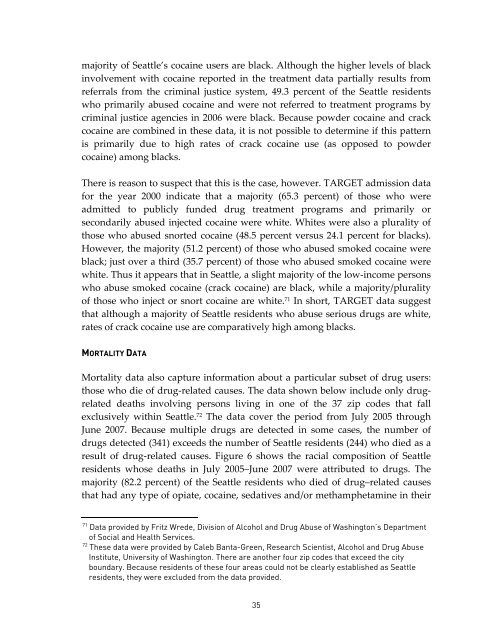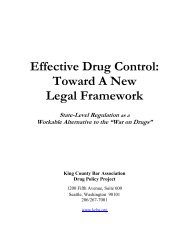RACE AND THE ENFORCEMENT OF DRUG DELIVERY LAWS IN ...
RACE AND THE ENFORCEMENT OF DRUG DELIVERY LAWS IN ...
RACE AND THE ENFORCEMENT OF DRUG DELIVERY LAWS IN ...
Create successful ePaper yourself
Turn your PDF publications into a flip-book with our unique Google optimized e-Paper software.
majority of Seattle’s cocaine users are black. Although the higher levels of black<br />
involvement with cocaine reported in the treatment data partially results from<br />
referrals from the criminal justice system, 49.3 percent of the Seattle residents<br />
who primarily abused cocaine and were not referred to treatment programs by<br />
criminal justice agencies in 2006 were black. Because powder cocaine and crack<br />
cocaine are combined in these data, it is not possible to determine if this pattern<br />
is primarily due to high rates of crack cocaine use (as opposed to powder<br />
cocaine) among blacks.<br />
There is reason to suspect that this is the case, however. TARGET admission data<br />
for the year 2000 indicate that a majority (65.3 percent) of those who were<br />
admitted to publicly funded drug treatment programs and primarily or<br />
secondarily abused injected cocaine were white. Whites were also a plurality of<br />
those who abused snorted cocaine (48.5 percent versus 24.1 percent for blacks).<br />
However, the majority (51.2 percent) of those who abused smoked cocaine were<br />
black; just over a third (35.7 percent) of those who abused smoked cocaine were<br />
white. Thus it appears that in Seattle, a slight majority of the low-income persons<br />
who abuse smoked cocaine (crack cocaine) are black, while a majority/plurality<br />
of those who inject or snort cocaine are white. 71 In short, TARGET data suggest<br />
that although a majority of Seattle residents who abuse serious drugs are white,<br />
rates of crack cocaine use are comparatively high among blacks.<br />
MORTALITY DATA<br />
Mortality data also capture information about a particular subset of drug users:<br />
those who die of drug-related causes. The data shown below include only drugrelated<br />
deaths involving persons living in one of the 37 zip codes that fall<br />
exclusively within Seattle. 72 The data cover the period from July 2005 through<br />
June 2007. Because multiple drugs are detected in some cases, the number of<br />
drugs detected (341) exceeds the number of Seattle residents (244) who died as a<br />
result of drug-related causes. Figure 6 shows the racial composition of Seattle<br />
residents whose deaths in July 2005–June 2007 were attributed to drugs. The<br />
majority (82.2 percent) of the Seattle residents who died of drug–related causes<br />
that had any type of opiate, cocaine, sedatives and/or methamphetamine in their<br />
71<br />
Data provided by Fritz Wrede, Division of Alcohol and Drug Abuse of Washington’s Department<br />
of Social and Health Services.<br />
72 These data were provided by Caleb Banta-Green, Research Scientist, Alcohol and Drug Abuse<br />
Institute, University of Washington. There are another four zip codes that exceed the city<br />
boundary. Because residents of these four areas could not be clearly established as Seattle<br />
residents, they were excluded from the data provided.<br />
35

















